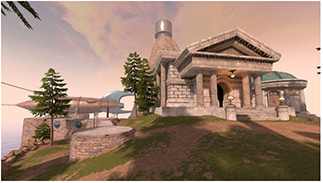Tip #1818: Myst (the Game) Expands into VR
… for Visual Effects
Tip #1818: Myst (the Game) Expands into VR
Larry Jordan – LarryJordan.com
Myst launched in 1993, and extended into VR in 2021.


This article, written by Chris McGowan, first appeared in VFXVoice.com. This is a summary.
When Myst debuted on CD-ROM in 1993, it stood apart from other video games at the time. The classic adventure title has no physical violence, there is no time limit, and the player never dies. There is no “game over.” Initially, it isn’t even clear what the game is. The user arrives at a starkly beautiful island world called Myst and must discover the nature of the game through exploration.
Now, in a move that seems long overdue, Cyan Worlds has released a $29.99 VR version of Myst for Oculus Quest headsets.
“The first time I experienced VR was back in the ‘90s. And I’ve known since then that Myst was destined to be experienced that way,” says Rand Miller, CEO of Mead, Washington-based Cyan Worlds. He and his brother Robyn designed and created the original game. “We’ve always felt that Myst in VR was a given, it was just a matter of timing. VR has been around for a while, but it’s taken a long time for it to reach a stage where it strikes the right balance of quality and accessibility. We felt like the time had arrived.”
The VR edition of Myst has new art, audio and interactions. Myst VR also has VR moves like teleporting, snap turns and using a hand to grab or pull or turn. And there is also a new randomized puzzle option. Cyan describes the new version as “fully redesigned and created from the ground up using Unreal Engine.” Miller explains that the original Myst “was our design doc for this new version of Myst, but there were certain changes that were necessary or desirable. From an artistic standpoint of course we wanted it to be Myst, but there were improvements that could be made. Beyond that there were numerous interface elements that needed to be changed to be used comfortably and intuitively in VR.”
Reflecting on the importance of the original Myst nearly thirty years later, Miller observes, “I think it was the idea that games could allow you to explore at your own pace, while uncovering a story in a visually appealing virtual world. In some ways maybe it had just enough elements of a real world to feel real.”
EXTRA CREDIT
The article includes a longer interview, images from Myst and thoughts on converting it from a Hypercard stack to the Unreal Engine.


Leave a Reply
Want to join the discussion?Feel free to contribute!